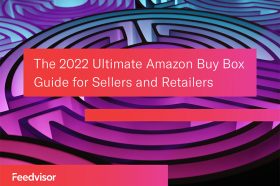Resources - Blog
How Neglecting Your Repricer Can Be Your Q4 Downfall

As online retailers, analyzing your business holistically is important year-round, but particularly in the fourth quarter and the ramp-up period leading up to it. Focusing on several elements of your business at a big-picture view will more effectively allow you to identify areas of risk, improve productivity, and benchmark your performance against the competition.
One of those elements that tends to fall to the wayside during the phase building up to the increase in search and conversion traffic in Q4 — which is arguably just as important of a time period as Q4 itself — is pricing. Many sellers deliberate back and forth and look at investing in various software, tools, and platforms to streamline operations as business-critical, but end up neglecting a pricing optimization solution.
Whether you are underinvesting in pricing optimization by not having a solution at all, having a solution and not leveraging it to your advantage during peak sales seasons, or are utilizing a rule-based repricer that can have a negative impact on your profit, you are running the risk of not being as profitable as you possibly can on every sale. It should be a priority for sellers, retailers, brands, and private labels to make the most of the busiest time of year and doing so through a productive pricing strategy, or risk losing out on conversions and marketplace visibility.
Stay on top of the latest e-commerce and marketplace trends.
Why a Rule-Based Repricer Can Stifle Q4 Pricing Capabilities
Rule-based repricing looks at your competitors’ prices for each SKU in your product mix, and then adjusts your price based on a set of predefined rules. For example, rules can be set to match the lowest price on the market, beat the lowest price by a certain dollar amount, or be in the lowest 20% of all prices. While rule-based repricing can be faster than manual repricing, the method comes with serious drawbacks for retailers.
First, the rules themselves can take a long time to set up. Next, they can become conflicting over time and need to be constantly monitored to ensure that they deliver strong performance in a variety of marketplace scenarios. Last and most importantly, rule-based repricers only take into account the competitors’ prices and ignore all the other seller metrics — a massive problem for any seller that analyzes their business on a holistic basis. You would be forced to disregard Buy Box share and profit margin, and would be unable to find the maximum profit potential. Here are several reasons that operating with a rule-based repricer can suppress your true profitability, particularly during the holiday season:
1. Your profits won’t be optimized. Although you may experience an increase in sales conversions with lower prices, this doesn’t necessarily translate into more profits. With an algorithmic repricer that identifies the comprehensive selling landscape — through real-time market dynamics, other sellers’ prices, and your optimal price — increasing your overall profits is the goal. If that means making fewer sales but at a higher margin until the product is ramped up, then so be it.
Algorithmic repricing harnesses big data and artificial intelligence to take all of your performance metrics into consideration (shipping time, customer response time, the makeup of your portfolio, etc.) and finds the most optimal price for you, according to your business strategies. During a time of frequent returns such as the November to January timeframe, it is important that you are maintaining healthy performance metrics and understanding which specific categories and SKUs may need more attention than others.
2. They price down instead of up. As we mentioned, given that rules-based repricers are bound to strict rules, they focus on driving prices down and ignore all other seller metrics outside of your competitors’ prices. They don’t analyze seller metrics, Buy Box share, MAP, or any other factors that determine how high you can price. This means that the repricer will lower your prices when you don’t need to. With the high demand that comes with Q4, the last thing you want to be doing is lowering your prices when there’s still existing demand for the items at higher prices.
3. The rules can be contradictory. Given that rule-based repricers operate according to a set of predefined rules, these rules often contradict each other. If there are no countermeasures in place to ensure that a product will not be repriced incorrectly, this can make a difference between an average and an above and beyond holiday season.
Historically, rule-based glitches have been known to wreak havoc among sellers’ catalogs during peak times of the year. For example, sellers have experienced certain items getting repriced down to zero (or close to it), causing their inventory to rapidly deplete and running their businesses into the ground during the season that should have been making them the most money.
Pricing Optimization Is Business-Critical
As Amazon continues to grow, running a business on the platform will continue to become more nuanced and complex, requiring the assistance of advanced technology. Today, we see more and more online retailers drawing this conclusion, realizing that it is a prerequisite for marketplace success — streamlining inventory management, drawing out impactful analytics, refining product offerings, and more. In Feedvisor’s 2018 report, The State of the Amazon Marketplace, data revealed that 53% of retailers with an annual sales volume above $2M are utilizing repricing software.
While both repricing technologies, algorithmic and rule-based, focus on increasing sales volume, profit margins, and Buy Box share, algorithmic repricers assess your entire competitive landscape over time, while rule-based repricers do not. Particularly during the holiday season, it will be business-critical to employ a solution that strives to predict how the hyper-competitive arena will evolve in the future and make more informed decisions based on these predictions. Since competition culminates during Q4, you should enlist a pricing optimization solution to help you remain competitive, avoid price wars, and increase engagement and customer loyalty.
Learn what Feedvisor can do for your business.
When you partner with Feedvisor, you automatically receive access to our true, AI-driven technology and hands-on team of e-commerce experts. Contact one of our team members today to learn more about our end-to-end solution for brands and large sellers on Amazon, Walmart, and e-marketplaces.



